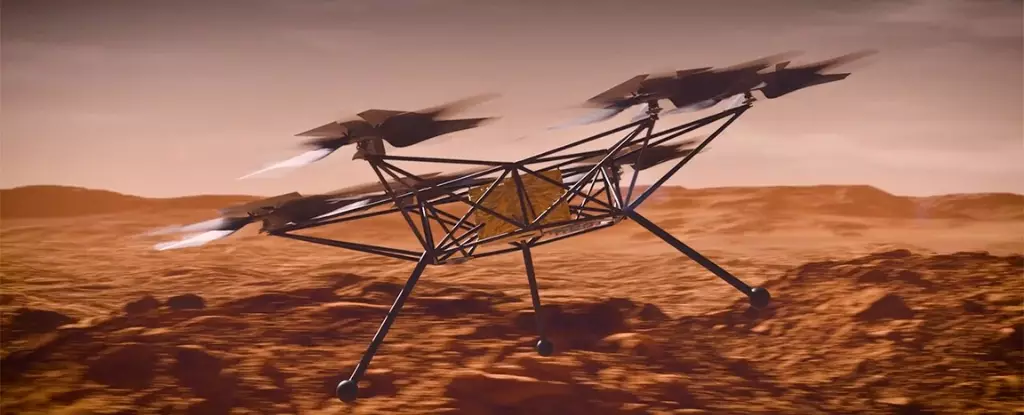In April 2021, a remarkable breakthrough in aerospace engineering unfolded when NASA’s Ingenuity helicopter made history by becoming the first powered aircraft to successfully fly on another planet. This achievement was not merely a technical demonstration; it ushered in a new era of exploration, revealing the potential of aerial vehicles to traverse alien landscapes. Ingenuity was part of the Perseverance rover mission, which landed on Mars in February 2021, brought along specifically to validate the feasibility of flight in Mars’ thin atmosphere. With a series of successful flights, Ingenuity successfully demonstrated that controlled, powered flight was not only possible but valuable in navigating and surveying the Martian environment.
The helicopter’s first flight was a modest yet significant feat, hovering just 10 feet above the surface. It marked the beginning of a series of 60 flights, consistently collecting valuable data and scouting areas of interest for deeper exploration by the Perseverance rover. Each flight brought unique insights into the Martian terrain, showcasing how aerial vehicles could complement surface missions by providing an overview of potential sites for further investigation.
Operating an aircraft on Mars poses a myriad of challenges largely due to its atmospheric conditions. Mars’ atmosphere is less than one percent the density of Earth’s, necessitating that aerial vehicles generate significantly more lift through their rotor systems. This difference not only influences the design of the vehicles but also imposes strict limitations on how they can operate. Additionally, dust storms and surface debris introduce another level of complexity, potentially risking damage to the craft’s intricate mechanisms. Therefore, robust engineering solutions are essential to ensure the stability and longevity of any flying vehicle on Mars.
The experiences and data collected from Ingenuity have been instrumental in addressing these challenges, guiding the development of future technologies suitable for Mars and other celestial bodies with similar conditions. NASA’s commitment to aerial exploration has revealed that overcoming these obstacles is vital for advancing our understanding of distant worlds.
Building on the triumphs of the Ingenuity helicopter, NASA has unveiled a computer rendering of its next-generation aerial vehicle, dubbed the Mars Chopper. This powerful design promises to be a game-changer for Martian exploration. Unlike its predecessor, the Mars Chopper will feature a significantly enhanced payload capacity, which allows it to carry sophisticated scientific instruments for tasks such as imaging, analysis, and terrain mapping.
Specifically, the design reveals a drone-like structure, comparable in size to an SUV, equipped with six rotors, each boasting six smaller blades. This configuration is specifically designed to maximize lift, further improving performance in Mars’ challenging atmospheric conditions. The current design speculates a payload capacity of 5 kilograms, allowing for extended operational range up to 3 kilometers. The collaborative effort between the Jet Propulsion Laboratory and the Ames Research Center underscores NASA’s commitment to advancing technology in support of interplanetary exploration.
The significance of the Mars Chopper extends beyond its technical specifications; it represents a leap forward in the way we approach the exploration of Martian soil. The vehicle’s capabilities enhance traditional ground-based rover missions by providing insights previously unattainable. No longer confined to just the rover’s immediate vicinity, scientists can now obtain vital data from a wider operational radius, enabling a more comprehensive understanding of the Martian environment.
Ultimately, this innovative aerial reconnaissance technology will play a crucial role in the broader goals of human exploration. As we aspire to send astronauts to Mars, having aerial vehicles capable of surveying and mapping uncharted terrains remotely will be invaluable. They will facilitate safe exploration by identifying optimal paths and sites for human activity, especially in regions that terrestrial rovers may find difficult to access.
The introduction of the Mars Chopper exemplifies NASA’s relentless pursuit of innovation in space exploration. As aerial technology advances, so too will our capacity to study other planets more effectively. The successes of Ingenuity not only validate the potential of aerial flight on Mars but also lay the groundwork for future explorations beyond our home planet. As we stand on the brink of interplanetary exploration, vehicles like the Mars Chopper not only broaden our horizon but also ignite the imagination, taking humanity one step closer to unlocking the mysteries of the universe.

